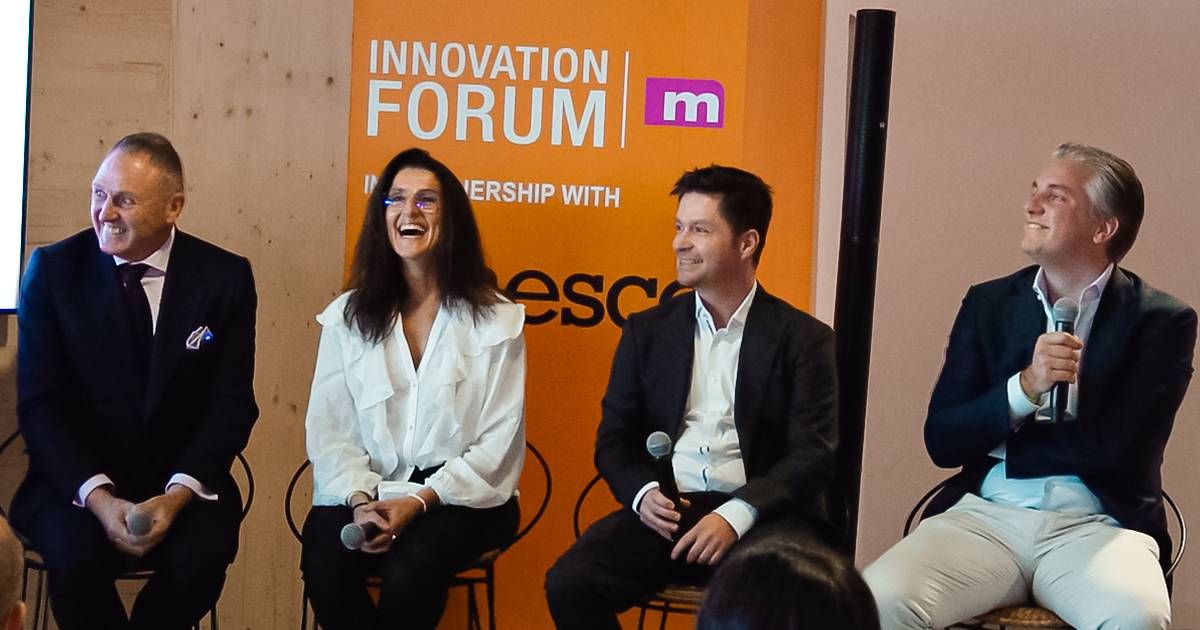Vemco Group’s participation at the leading global retail event, MAPIC 2021, was an unequivocal success. The company was present throughout the event to demonstrate its highly developed Vemcount software, which has benefitted retailers and mall owners, among others, since its launch in 2009. At the Vemco Group stand, curious visitors were given insight into the innovative Vem-modules and highly advanced sensor technology used to provide clients with valuable data for business optimization.
On December 1st, the CEO and founder of Vemco Group, Anel Turkanovic, engaged in a captivating panel discussion to discuss the merging of the digital and physical in shopping malls. Anel was joined by Eurofund President, Ian Sandford, General Manager at Al-Futtaim Malls Group, Mary Del Dosso, and CEO of Wereldhave, Matthijs Storm, who are all important figures in the retail and mall industry. FitForCommerce Managing Director and discussion moderator, Gary Burrows, instigated the main topic of discussion: Disruption – and how the digital evolution of malls is leaping forward. This topic constituted a discussion that brought on many interesting dilemmas, debates, and ideas, including discussions of digital versus physical sales, what 2030 might look like, and which technologies are being developed to aid the current evolution of malls.
Optimizing Shopping Malls & Making Experiences
Burrows kicked off the discussion, asking what kind of technologies are being implemented to keep up with the digital evolution that has blossomed and skyrocketed during Covid-19. Ian Sandford shared his opinions, stating that his utmost goal is creating a space where people wish to spend their time – and using data to create such place. Mary Del Dosso agreed on the need for data, especially data that gives you valuable insight into customer journey. With valuable data provided by the Vemcount software, Mary believes we can create great spaces for everyone.
For the past seven years, Vemco Group has, in close collaboration with Danish shopping malls, developed a specially designed Vem-module, Vemtenant, to improve the relationship between mall owners and their tenants. Anel Turkanovic introduces this solution, which combines and provides the best technology for accurate data. It allows mall owners to collect store turnover and make data-based decisions to optimize mall layout, enhance customer experience, and adjust rent pricing to match incoming data. According to Anel, the future lies in data, and data-based tenant rent pricing.
Matthijs Storm chimes in, stressing the importance of Ship from Store. He notes how he has been met with skepticism by using this method. People tend to say: “But we want people to come to our malls and not have stuff delivered to their house”. However, Matthijs calls it being realistic. The most convenient thing is having items delivered to your house. Therefore, we must adapt to the needs and desires of our consumers if we are to survive - jump on the bandwagon, as Matthijs puts it. He goes on to tell the audience about Wereldhave’s partner platform Connect, which is a platform allowing consumers to order groceries online and have them delivered directly to their homes.
Adaptation Is Key
One key topic of the discussion was, in fact, the ways in which big data can improve customer experience and journey. What most participators agreed on was the increasing need to turn malls into more than merely a shopping place: it needs to be an experience. With the way technology is evolving, there is a rising need to create so-called “super houses” that attract and tempt visitors with more than retail stores. As President of Eurofund, Ian Sandford put it, there is no need for any shopping centers in this world anymore. Everything can be bought online. If we are to change this, we need to create a space, beyond shopping, where people wish to go and spend their time.
To create such space and improve CX, we need data – specifically how we use it, according to Matthijs. Data helps solve the puzzle of a mall, i.e., moving retailers around, ensuring they are located in a spot, where store turnover and customer journey align. In that case, trust and transparency are keywords for a smooth-running and successful mall. Anel notes the way Vemco Group’s Vemtenant helps mall owners and retailers cooperate by sharing valuable data with each other, including store-front analyses, passersby numbers, turnover, customer journeys, and more. Shared data lets mall owners know what goes on inside a store, while tenants get valuable data about what happens outside of their store. This way, mall owners and tenants can create a two-communication relationship that is trustful and transparent.
Evidently, malls need to be driven by technology and data. With the constant evolution of technology, which includes an increase in self-check-out, click & collect, home deliveries, and even drone deliveries in places, such as Dubai, we need to adapt in ways that can ensure the survival of shopping malls. Adapting to self-check-out means knowing the benefits of reducing staff at check-out counters. Self-check-out allows mall owners and retailers to allocate the previously needed staff elsewhere to enhance customer service. Higher customer service equals an improved customer experience, which is crucial for malls’ survival. It is, as emphasized frequently during the discussion, all about the experience!
Fixing the Problems & Keeping Up with Technology
An ongoing problem vocalized during the panel discussion, was the difficulties surrounding online shopping and knowing the true worth of your shoppers or real estate. How do mall owners know the value of their assets? They can’t, according to Ian Sandford. Unless Zara.com opens inside a mall, there are huge problems surrounding knowing the true worth of your store or mall. Online sales are not part of the imported turnover, making it difficult to know just how many sales a store generates. A physical store can still play a hand in generating an online sale. Let us say, a staff member guides you to their web shop if a desired color or size is not in stock at the physical store. Then, the customer goes home and purchases the item, without appearing in the store’s turnover, even though the physical store helped generate that sale. This is a huge problem in the retail industry.
To solve the problem, Anel believes that data-based rent pricing is the future. If mall owners calculate rent based on data, such as footfall numbers, conversion rates, traffic flow, and more, it need not matter if the customer went home and placed the order after their visit to the store. Their visit still shows up as part of the store’s data, helping mall owners calculate a renting price that matches the store’s data numbers.
While there are always miles to go in keeping up with technology, using big data is an efficient way to stay on an innovative, progressive course. We need to listen to what the consumer wants in a mall and act accordingly. Data is a crucial benefactor here. It gives you valuable insight into customer journey, dwell times and areas, conversion rates, captive rate, and much more. With big data, you are on the right path to success.
Vemco Group was honored to be at MAPIC 2021 and take part in such an enthralling panel discussion, shedding light on the difficulties that lie in the mall industry and the opportunities data provides for improvement.




.jpg?width=352&name=MBYH8963%20(1).jpg)
